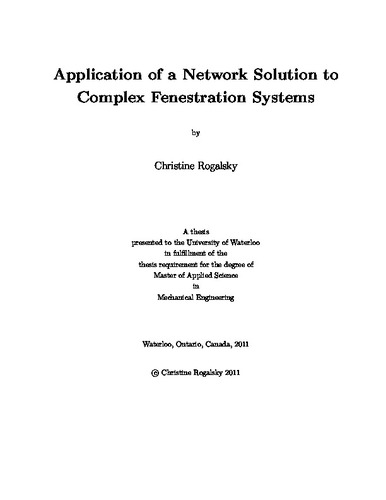| dc.description.abstract | In the fight to reduce carbon emissions, it is easy to see the necessity of reducing energy consumption. Buildings consume a large amount of energy, and have significant potential for energy savings. One tool for realising these potential savings is building simulation. To be able to use building simulation, accurate models for windows are needed. The models include individual layer models, to determine the solar and longwave radiative behaviours,
as well as whole-system models to determine heat flows through the various layers of
fenestration systems.
This thesis looks at both kinds of models for incorporating windows into building
simulations. A new network whole-system model is implemented, and integrated into the
California Simulation Engine building simulation software. This model is also used as the calculation engine for a stand-alone rating tool. Additionally, a measurement technique used to measure off-normal solar properties of drapery materials, as part of developing shading layer models, is investigated using a Monte Carlo simulation.
The network model uses a very general resistance network, allowing heat transfer between any two layers in a complex fenestration system (CFS), whether they are adjacent or not, between any layer and the indoor or outdoor side, or between the indoor and outdoor sides, although this last case is unlikely. Convective and radiative heat transfer are treated using the same format, resulting in increased stability. This general resistance network is
used to calculate indices of merit for the CFS using numerical experiments. This approach requires fewer iterations to solve than previous solution methods, and is more
flexible.
The off-normal measurement technique which was investigated used a sample holder
inserted into an integrating sphere. This is a non-standard way of using an integrating
sphere, and early analyses did not provide conclusive information as to the effect of the sample holder. A Monte Carlo analysis confirmed the amount of beam attenuation as being 20% for the sample holder used in the experiments. Also con firmed was the effectiveness of dual-beam integrating spheres in correcting for the presence of a sample holder.
The stand-alone rating tool which uses the general network framework, incorporates
an easy-to-use visual interface. This tool models multiple types of shading layers with
no restrictions on how they are combined. Users can easily change any one layer to see
the effects of different arrangements. Users may specify any combination of indoor and
outdoor ambient and mean radiant temperatures, insolation, and beam/diffuse split. | en |

